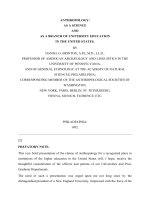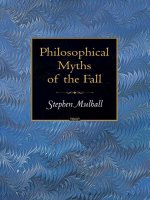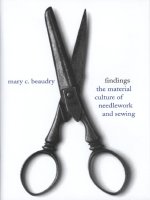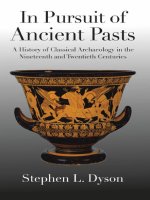yale university press in pursuit of ancient pasts a history of classical archaeology in the nineteenth and twentieth centuries oct 2006
Bạn đang xem bản rút gọn của tài liệu. Xem và tải ngay bản đầy đủ của tài liệu tại đây (1023.4 KB, 335 trang )
In Pursuit of Ancient Pasts
Stephen L. Dyson
In Pursuit of
Ancient Pasts
A History of Classical Archaeology in the
Nineteenth and Twentieth Centuries
YALE UNIVERSITY PRESS NEW HAVEN & LONDON
Copyright © 2006 by Yale University.
All rights reserved.
This book may not be reproduced, in whole or in part, including illustrations, in any
form (beyond that copying permitted by Sections 107 and 108 of the U.S. Copyright
Law and except by reviewers for the public press), without written permission from
the publishers.
Set in Linotype Fairfi eld by Duke & Company, Devon, Pennsylvania.
Printed in the United States of America by Sheridan Books.
Library of Congress Cataloging-in-Publication Data
Dyson, Stephen L.
In pursuit of ancient pasts : a history of classical archaeology in the nineteenth
and twentieth centuries / Stephen L. Dyson.
p. cm.
Includes bibliographical references and index.
ISBN-13: 978-0-300-11097-5 (alk. paper)
ISBN-10: 0-300-11097-9 (alk. paper)
1. Archaeology—History—19th century. 2. Archaeology—History—20th century.
3. Classical antiquities. 4. Archaeology and history—Mediterranean Region.
5. Mediterranean Region—Antiquities. I. Title.
CC100.D97 2006
930.1—dc22
2006017553
A catalogue record for this book is available from the British Library.
The paper in this book meets the guidelines for permanence and durability of the
Committee on Production Guidelines for Book Longevity of the Council on Library
Resources.
10 9 8 7 6 5 4 3 2 1
For
Abigail
Daniel
Jacob
Jonathan
Peter
Simona
Contents
Preface ix
Acknowledgments xv
Chapter 1. The Protohistory of Classical Archaeology 1
Chapter 2. The Foundations of Classical Archaeology 20
Chapter 3. The Opening of Greece 65
Chapter 4. Nationalism and National Traditions Before the
Great War 86
Chapter 5. The Emergence of the Great Museums in Europe
and America 133
Chapter 6. Political Ideology and Colonial Opportunism
During the Interwar Period 172
Chapter 7. After World War II: Capitalism, Corporatism,
and Marxism 214
Afterword 249
Notes 255
Bibliography 279
Index 305
xi
Preface
This is a book about classical archaeology in the past two centuries. It
explores the changes in the modern age to a fi eld of study that by then
was already old. This was the period in which an avocational interest
became an academic discipline. But classical archaeology had many
other faces during this period. The expansion of the educated middle
class created new rosters of amateurs who identifi ed with the Greek and
Roman past. These amateurs formed the legions of new tourists who
replaced the Grand Tour aristocrats at Rome and Pompeii. Histories and
myths associated with ancient Greece and Rome became caught up with
national histories in an imperialist age. A French emperor sponsored
the excavation of the hill fort where Julius Caesar defeated the Gallic
chieftain Vercingetorix. An Italian dictator demanded that archaeologists
clear the fora of the Caesars to provide an appropriate backdrop to his
military parades. A history of classical archaeology during the past two
hundred years, then, must be a history of professionalization and the
advancement of knowledge, but it must also be a cultural, social, and
even political history.
Much has been written about the history of classical archaeology
from the Renaissance to the early years of the nineteenth century. These
were the centuries when classical antiquity was rediscovered, when the
arts developed in close connection with classical models, when the col-
lecting of ancient sculpture, coins, and other antiquities was central to
humanists. Education still included the classics, and most cultivated
people had more than a passing knowledge of Greek and Roman authors.
The antiquarians who dominated archaeological study in the seven teenth
and early eighteenth centuries laid foundations on which we still build
today through their methodical marshaling of information in a number
of archaeological fi elds. Many who once mocked those dusty pedants
and their quaint ways have developed an admiration for these scholars’
persistent hard work and their impressive accumulation of knowledge.
In the eighteenth century archaeology moved in many directions.
xii PREFACE
The discoveries at Herculaneum and Pompeii made more immediate the
Roman past. The French turned to Rome as they shaped their evolving
ideologies of the prerevolutionary, revolutionary, and Napoleonic eras.
The youth of the ruling class of that emerging power England experi-
enced ancient Rome fi rst through the classical curricula of Oxford and
Cambridge and then on the Grand Tour. The collecting mania associ-
ated with the Grand Tour helped create the international antiquities
market and laid the foundations of many great collections north of the
Alps. A neoclassical revival in the arts spread throughout Europe, and
the fi rst small expeditions were dispatched to Greece to study classical
art at what the classical humanist Johann Winckelmann proclaimed
was its source.
After the defeat of Napoleon the history of classical archaeology
seemed to grow progressively duller, as the study attracted the interest
only of specialists. The ephemeral brilliance of Napoleon was replaced
by a succession of pedantic German professors, and the decadent young
aristocrats of the Grand Tour by earnest tourists, Baedekers in hand,
who invaded every gallery determined to study every statue. Neoclassi-
cal art, considered cutting edge in the eighteenth century, moved to an
increasingly marginalized backwater in the nineteenth, represented by
Henry James’s “white marmorean fl ock” of American women sculptors
carving marble nymphs in Rome. Even the archaeological adventurers
like the Englishman Charles Newton, who fi lled the museums of Europe
with original Greek art, have attracted relatively little attention.
While it is true that the classical has not dominated the cultural
world in the past two centuries in the way it did the previous three, it was
hardly a minor presence. Greece and Rome remained central not only to
elite but also to middle-class education in Europe and America during
the nineteenth century and much of the twentieth. The nineteenth-
century phenomenon of middle-class American women gazing appre-
ciatively at the Apollo Belvedere while their husbands commissioned
Greek Revival houses shows the hold the classical aesthetic still had on
educated society. If its characteristic archaeological manifestation in the
mid-eighteenth century was a British Grand Tourist visiting the Vatican
galleries, in the late twentieth century it was Archaeology magazine in
the dentist’s offi ce.
Writing the more recent history of classical archaeology is a com-
plicated task. During this period classical archaeology became a profes-
PREFACE xiii
sional discipline with more than its share of the institutions devoted to
its study, and disciplinary and institutional development from profes-
sorships in Berlin to museums in Munich to research and study centers
in Athens and Rome have to be considered. So do the major research
projects, especially that late-nineteenth-century archaeological innova-
tion, the “big dig.”
But there is danger in an institutional approach to the history of
classical archaeology, where an emphasis on the professional may lead
to little more than a parade of dead academics, dusty excavations, and
silent libraries. Certainly, university seminars, scholarly libraries, re-
search institutes, and well-organized and well-funded excavations laid
the foundations of a modern, professional, classical archaeology. But
these instruments of disciplinary professionalism developed at a very
uneven pace.
The Germans led the way, and, ironically, it was in the raw land
of America that German classical scholarship probably had its great-
est formative infl uence. Many of the founding generation of American
classicists had studied in Germany. The French always looked skepti-
cally on things German, although they paid more attention to German
scholarly accomplishments in the 1870s after the German victory in the
Franco-Prussian War. The British universities retained a solid classical
curriculum into which archaeology penetrated only marginally up until
World War I. In the British Museum they had access to the best collec-
tion of original Greek sculpture in the world, but the museum classical
archaeologists were few in number and amateur in education. In Rome,
the capital of a newly united Italy, classical archaeology did not enter the
university as a formal fi eld of study until the last years of the nineteenth
century, although after that German scholarship had a dominant—some
would have said too dominant—position there.
To focus simply on professional classical archaeology and archaeolo-
gists in the nineteenth century would be too limiting. Field archaeology
had originated with the amateur antiquaries, and for much of Europe the
antiquary remained the principal source of archaeological research well
into the twentieth century. These parochial savants, with their dusty col-
lections of antiquities and querulous meetings, where they argued over
the location of some Roman town mentioned by Tacitus, became an ob-
ject of fun and even of derision. However, many were deeply learned and
knew much of the world outside their local areas; they played a vital role
xiv PREFACE
in recording information on sites that have now been destroyed and in
saving antiquities that would almost certainly have been lost. Important
fi elds of archaeological study like Roman Britain remained until the 1960s
largely the domain of the amateur. It is one of the aims of this book to
give these often-underappreciated scholars their due, both for their role
in the advancement of knowledge and for their preservation of an interest
in the subject outside the increasingly isolated world of the academies.
Yet classical archaeology continued to appeal to large segments of the
educated public beyond the professors and the antiquaries. This interest
refl ected the ongoing importance of Greece and Rome in the political
and cultural ideologies of Europe and America. The newly emerging
middle classes responded to the new publications and institutions like
guidebooks and public museums that aimed to bring the latest discover-
ies and theories to an educated but more bourgeois public. Recent inven-
tions like photography were soon harnessed to the cause of archaeologi-
cal popularization. This new world of archaeological communication
deserves as much attention as the history of the scholarly monograph, for
it sustained a broad base of support for what was often an arcane activity.
Many of the new professionals appreciated the importance of this
emerging educated class and sought new ways to communicate with
the wider public. The nineteenth century produced a surge of activity
directed toward this public, including the foundation of new museums
and the reevaluation of the role of older museums. A booming industry in
casts arose, enabling museums and colleges to have their own collections
of life-size copies of the great works of Greek and Roman art. Photo-
graphs served as research tools; fi rst came individual photograph prints,
then books illustrated with photographs, and fi nally lantern slides.
During the nineteenth century classics and classical archaeology
were also enlisted in the service of Western colonialism. The Oxbridge
elite were taught that they were the new Platonic guardians and Roman
proconsuls in a neo-Roman Empire. French and Italian military offi cers
excavated Roman sites in North Africa not only out of intellectual cu-
riosity but also to establish a visual and ideological link between past
and present colonialism. These empires often interacted in complex and
fruitful ways. The Oxford ancient historian Francis Haverfi eld recon-
structed a Roman Britain that clearly owed much to his contemporary
experience of British imperialism.
I have tried to incorporate these themes and more into this book,
PREFACE xv
yet it is a very personal history of classical archaeology. It has to be. A
history of classical archaeology that attempted to discuss all signifi cant
individuals, institutions, and events in detail would probably never get
written and, if written, would be ponderous and unreadable. I have
selected subjects and themes that I think are important and have il-
lustrated them with what I consider the most pertinent examples. In
addition, certain important national histories of the study of classical
archaeology have received little attention, owing to limitations of both
space and competence. I would have liked to have said more about
classical archaeology in both Russia and the Soviet Union, a tradition
that produced the important fi gure Michael Rostovtzeff. But doing so
would have required a mastery of the Russian language that I do not
have, so I have only touched briefl y upon Rostovtzeff. Similar problems
arose with the history of classical archaeology in Scandinavia. As well,
classical archaeology has a long and interesting history in the Iberian
peninsula, but I do not consider it central to the development of the
discipline and therefore omitted it here.
Readers expecting to encounter the exploits of Heinrich Schliemann
may be disappointed, for I have not considered the archaeology of the
Minoan-Mycenaean world, even though it is closely linked to classical
archaeology. Schliemann appears only briefl y in my account. In part
this is because a good historical account of the development of the ar-
chaeology of Bronze Age Greece already exists: William McDonald and
Carol Thomas’s Progress into the Past (1990). In addition, to examine the
topic of the development of the archaeology of pre-Classical Greece and
Rome would require consideration of Near Eastern archaeology and the
prehistoric archaeology of the Mediterranean and even that of Western
Europe, making the study so large as to risk becoming unmanageable.
Those are all topics worthy of investigation, but not here.
I end the narrative with the 1970s. Although important archaeological
discoveries took place after this time, the discipline in my view generally
continued to move along paths established by the 1970s. I have written
elsewhere about what I see as the problems of contemporary classical
archaeology, especially in the United States, and don’t need to repeat
those arguments here. (It is also diffi cult to write sine ira et studio about
the generation of which you are a part.) Many will disagree with what I
say here, and I hope that this exercise in archaeological history inspires
or outrages others to write their own.









